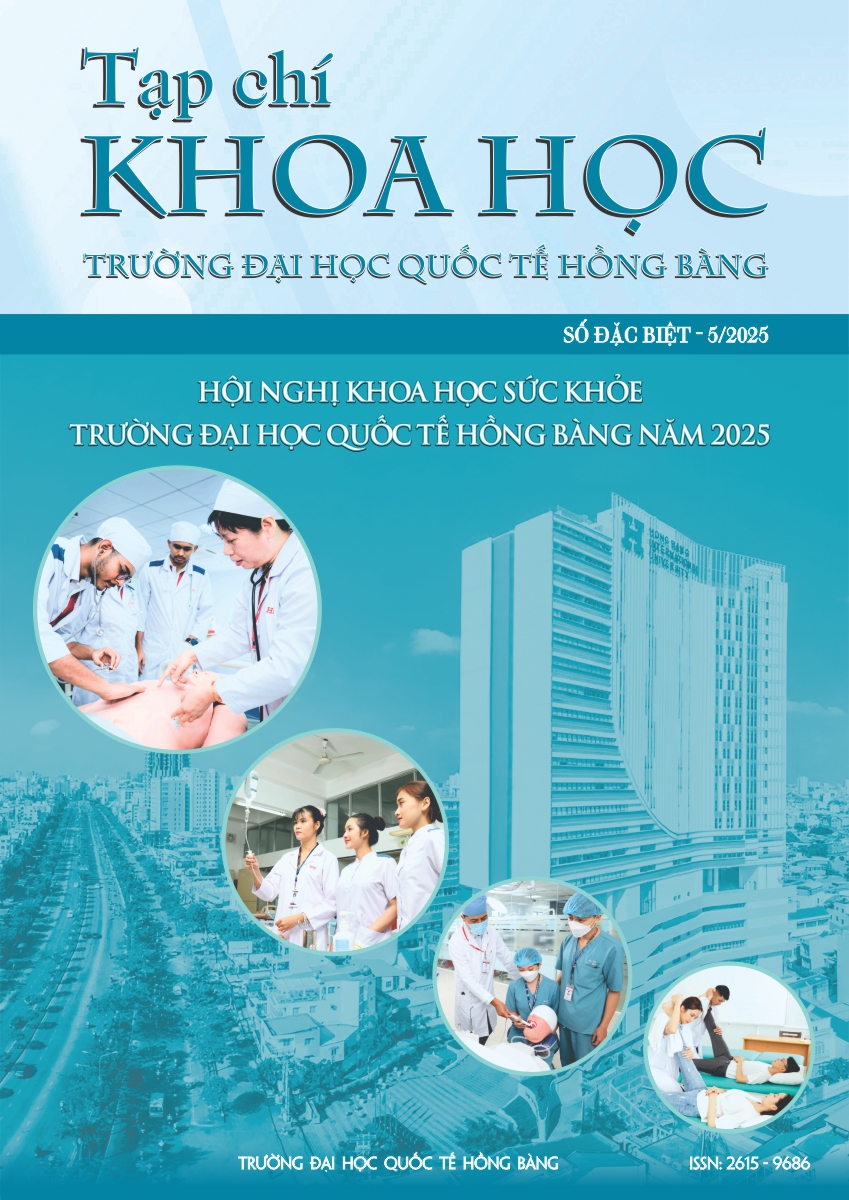ĐẶC ĐIỂM THỰC VẬT VÀ SƠ BỘ THÀNH PHẦN HÓA THỰC VẬT CỦA CÂY NỌC XOÀI (Struchium sparganophorum (L.) Kuntze.), HỌ CÚC (ASTERACEAE)
Các tác giả
DOI: https://doi.org/10.59294/HIUJS.KHSK.2025.020Từ khóa:
Struchium sparganophorum, đặc điểm vi phẫu - soi bột, sơ bộ thành phần hoá thực vậtTóm tắt
Đặt vấn đề: Nọc xoài (Struchium sparganophorum (L.) Kuntze., họ Asteraceae) được sử dụng theo kinh nghiệm dân gian để sát trùng, giảm sưng viêm, trị mụn bọc, cầm máu, làm lành vết thương, làm dịu da, giảm thâm nám, … Tuy nhiên vẫn chưa có nhiều nghiên cứu về loài cây này. Mục tiêu nghiên cứu: Phân tích đặc điểm thực vật và sơ bộ thành phần hoá học của cây Nọc xoài. Đối tượng và phương pháp nghiên cứu: Cây Nọc xoài được thu mẫu tại tỉnh Đồng Tháp để phân tích đặc điểm hình thái, giải phẫu, soi bột và sơ bộ thành phần hoá thực vật bằng phương pháp Ciulei cải tiến. Kết quả: Nghiên cứu đã mô tả chi tiết đặc điểm hình thái và cấu tạo vi phẫu của cây Nọc xoài. Phân tích vi phẫu cho thấy sự hiện diện của lông che chở hình chữ T, mô mềm chứa ống tiết nhựa và cấu trúc bó libe gỗ đặc trưng. Phân tích sơ bộ thành phần hóa thực vật bột lá hoặc toàn cây, cho thấy có sự hiện diện của các nhóm hợp chất có tiềm năng ứng dụng như flavonoid, alkaloid, saponin, glycosid, antraquinon và coumarin. Kết luận: Kết quả nghiên cứu chi tiết về hình thái, giải phẫu thực vật của cây Nọc xoài thu mẫu tại Việt Nam góp phần quan trọng trong định danh loài và tiêu chuẩn hoá về thực vật cho nghiên cứu ứng dụng.
Abstract
Background: According to folk experience, Struchium sparganophorum (L.) Kuntze., Asteraceae family, has been used to disinfect, reduce swelling, treat acne, hemostasis, heal wounds soothe the skin, reduce melasma, … However, there have been few studies on this plant. Objectives: The aim of the study is to investigate the microscopic characteristics and preliminary phytochemical screening of S. sparganophorum. Materials and Methods: Whole plant of S. sparganophorum was collected in Dong Thap province. The botanical characteristics of S. sparganophorum were analyzed by morphological and anatomical examinations, using magnifying glass and optical microscope. Dried powder of S. sparganophorum was microscopically examined. Preliminary analysis of phytochemical composition was performed by modified Ciulei method. Results: The research has described in detail the morphological characteristics and microscopic structure of S. sparganophorum. Microscopic characteristics of this plant demonstrated the presence of T-shaped trichomes, soft tissue contains resin ducts and characteristic vascular bundle structure. Phytochemical screening revealed the presence of several classes of compounds, including flavonoids, alkaloids, saponins, glycosides, anthraquinones, and coumarins, which are known to have potential applications in medicine. Conclusion: The study described in detail anatomical characteristics and powder components of S. sparganophorum collected in Vietnam. The results provide the botanical profile for species identification and microscopic authentication in applied research of this medicinal plant.
Tài liệu tham khảo
[1] https://tracuuduoclieu.vn/struchium-sparganophorum-l-kuntze.html. Cập nhật: 10/4/2023. [Truy cập: 27/02/2025].
[2] G. Oboh, "Nutritive value, Antioxidant and Antimicrobial properties of Struchium sparganophora leaves", Journal of Medicinal Food, vol. 9, no. 2, pp. 276-280, 2006.
DOI: https://doi.org/10.1089/jmf.2006.9.276[3] P. A. Akah and R. R. Ekekwe, “Ethnopharmacology of Some Asteraceae Family Used in Nigeria Traditional Medicine”, Fitoterapia, vol. 66, pp. 351-355, 1995.
[4] B. A. Ayinde and U. Agbakwuru, "Cytotoxic and growth inhibitory effects of the methanol extract Struchium sparganophora Ktze. (Asteraceae) leaves", Pharmacognosy Magazine, vol. 6, no. 24, pp. 293-297, 2010.
DOI: https://doi.org/10.4103/0973-1296.71795[5] A. Francis, P. P. Bijeshmon, K. Meera Mohan, K. M. Greeshma, and A. M. Sabeena, “Phytochemical characterization, microscopic evaluation, and TLC profiling of Struchium sparganophorum (L.) Kuntze: A comprehensive pharmacognostic study,” International Journal of Pharmacognosy and Phytochemical Research, vol. 9, no. 10, pp. 16-20, 2024.
[6] N. T. T. Trâm, "Góp phần tìm hiểu thành phần hóa học của cây Cốc đồng (Struchium sparganophorum (L.) O. Ktze.), Họ Cúc (Asteraceae), Luận văn tốt nghiệp Thạc sĩ Hóa học, Trường Đại học Khoa học tự nhiên, 2007.
[7] Bộ Y tế, Dược điển Việt Nam V, 2018.
[8] Bộ Y tế, “Thực vật Dược”, chủ biên TS. Trương Thị Đẹp, Nhà xuất bản Giáo Dục, 2007.
[9] Bộ môn Dược liệu, Trường Đại Học Quốc tế Hồng Bàng, “Giáo trình Dược liệu - Thực vật dược”, 2022.
[10] T. Hùng và cộng sự, “Phương pháp nghiên cứu dược liệu”, Đại học Y Dược thành phố Hồ Chí Minh, 2015.
[11] S. Bunwong, P. Chantaranothai, S. Keeley, “Revisions and key to the Vernonieae (Compositae) of Thailand”, PhytoKeys, vol. 37, pp. 25-101, 2014.
DOI: https://doi.org/10.3897/phytokeys.37.6499[12] M. S. Uddin and S. B. Uddin, “Struchium sparganophorum (L.) Kuntze (Asteraceae): A new angiosperm record for the flora of Bangladesh”, Bangladesh Journal of Plant Taxonomy, vol. 29, no. 2, pp. 431-435, 2022.
DOI: https://doi.org/10.3329/bjpt.v29i2.63537[13] S. O. Salawu, D. M. Sanni, A. A. Akindahunsi, “HPLC/DAD/MS phenolic profile, antioxidant activities and inhibitory action of Struchium sparganophora (Linn) and Telfairia occidentalis (Hook. F) Against low density lipoprotein oxidation”, African Journal of Food Science and Technology, vol. 4, no. 1, pp. 1-8, 2013.
Tải xuống
Tải xuống: 232











